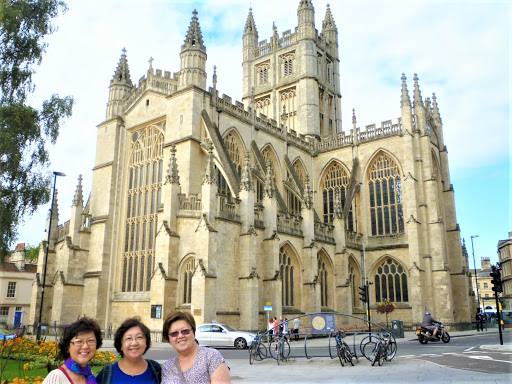It was already evening by the time we checked into Lindisfarne Guest House in Bath on 15 August 2014. Nestled in the charming village of Bathampton, Lindisfarne is a delightful house set within well-kept gardens, conveniently located just off the roadside. The guest house offers a peaceful retreat while being only 1.5 miles from the historic centre of Bath. This iconic city, situated in Somerset in the southwest of England, is renowned for its Georgian architecture, Roman Baths, and rich cultural heritage.
************************************************************
Although we had a car, we were advised against driving into Bath city centre due to the high parking charges. Taking that advice, we opted for a taxi instead, which turned out to be a convenient and hassle-free way to get into the heart of the city.
Bath, designated a UNESCO World Heritage Site in 1987, attracts nearly 4 million day visitors and around 1 million overnight guests each year. Its fame dates back to ancient times, largely due to the natural hot springs discovered in the area. By AD 60, the Romans had transformed the settlement into a spa town, constructing elaborate baths and a temple dedicated to the goddess Sulis Minerva.
To explore the city, we took a ride on a double-decker sightseeing bus. It was an excellent way to quickly gain an overview of Bath’s rich history while enjoying panoramic views of its stunning Georgian architecture and scenic surroundings.
The decision to impose high parking rates has proven wise for a city so dependent on tourism. By discouraging excessive car use, Bath preserves its charming atmosphere and allows visitors to explore with greater ease and safety - free from the congestion that often plagues other historic cities.










*************************************************************
We visited the Abbey Church of St. Peter and St. Paul, more commonly known as Bath Abbey. This magnificent Gothic structure, with its striking fan-vaulted ceiling and stained glass windows, stands as one of the city’s most iconic landmarks. Designed in the shape of a cruciform, the church can accommodate around 1,200 people and serves multiple purposes - from regular religious services to secular civic ceremonies, concerts, and public lectures.
During our visit, the atmosphere was particularly special, as a wedding ceremony had just concluded. The lingering floral arrangements and joyful mood added a unique charm to our experience, offering a glimpse into how this historic space continues to be a living part of the community.
************************************************************
The River Avon winds its way through the heart of Bath, adding to the city’s timeless charm. We took a leisurely river cruise along its tranquil waters, which offered us a different perspective of Bath - one that revealed its picturesque scenery, elegant Georgian architecture, and peaceful riverside views. Gliding past historic bridges and lush greenery, the cruise was a relaxing and scenic way to experience another side of the city beyond its busy streets and landmarks.
While seated inside the boat, I happened to glance upward - and a chill ran down my spine as I took in the sight of buildings perched seemingly precariously on cantilevered supports above the riverbank. It was both awe-inspiring and unsettling. The builders and engineers of a bygone era were clearly both bold and highly skilled. Their craftsmanship has stood the test of time, with structures that appear to defy gravity yet remain firmly intact to this day.
One particular bridge we passed over the River Avon reminded me of the old London Bridge, where buildings once lined either side. Here, a row of small units has been constructed along one side of the bridge - modest in size but full of character. These spaces now house quaint souvenir shops and cosy eateries, catering to the steady stream of tourists drawn to Bath’s historic charm.
























































